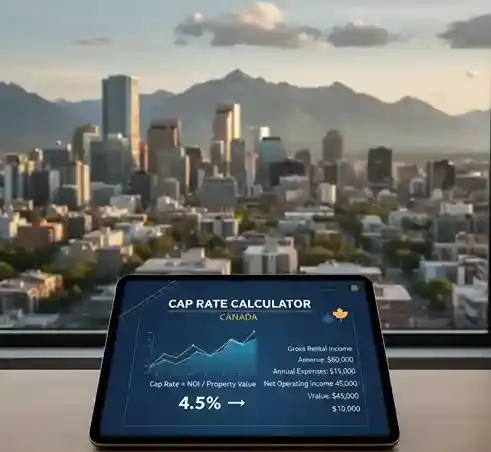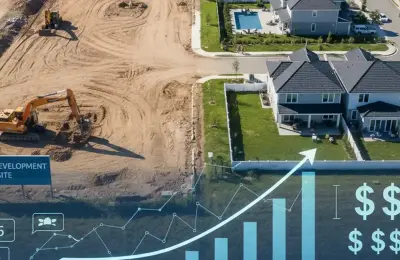
Cap Rate Calculator Canada: How to Calculate Rental Property Profitability in Canada (Capitalization Rate)

A superb tool for evaluating the potential profitability of investment rental property in Canada is the Capitalization Rate, or Cap Rate. This metric helps investors compare different properties and assess their attractiveness, regardless of how they are financed.
What is the Cap Rate and Why is it Important for Canada?
The Cap Rate is the ratio of a property’s Net Operating Income (NOI) to its current market value or purchase price. Expressed as a percentage, it shows the annual return (if the property were bought with all cash) generated by the real estate relative to its value.
For investors in Canada, understanding the Cap Rate is critically important because:
- Comparison: It allows for a quick comparison of rental property profitability across different types of real estate (e.g., condos, townhouses, multiplexes) in various cities (Toronto, Vancouver, Montreal, etc.).
- Risk Assessment: Generally, a higher Cap Rate may indicate potentially greater returns, but it can also signal higher risk (e.g., an older property, higher vacancy, less stable market).
- Valuation: Investors and appraisers often use the average Cap Rate for similar properties in the market to quickly determine fair market value (Property Value = NOI / Cap Rate).
The Cap Rate Formula: Your Cap Rate Calculator Canada
Calculating the Cap Rate involves two key steps: determining the Net Operating Income (NOI) and applying the main formula.
Step 1: Calculating Net Operating Income (NOI)
Net Operating Income (NOI) is the annual income a property generates, minus all annual operating expenses. Important: NOI does not include debt service costs (mortgage payments) or income tax, as the Cap Rate should evaluate the asset's performance itself, not a specific investor's financing structure.
1. Gross Annual Income:
- Annual rent (Monthly Rent×12)
- Other income (e.g., from parking, laundry, late fees).
2. Total Annual Operating Expenses:
- Property Taxes
- Insurance (e.g., Home Insurance)
- Utilities (if paid by the landlord)
- Condo Fees (if applicable)
- Maintenance and repair costs (typically 5-10% of gross income)
- Property management fees (if applicable)
- Vacancy allowance (expected downtime, e.g., 5% of potential income)
Step 2: Applying the Cap Rate Formula
Once you have the NOI, you can calculate the profitability using the Cap Rate formula:
Canadian Calculation Example: 🇨🇦
Suppose you are considering a multiplex in Calgary:
- Gross Annual Rent: $60,000 CAD
- Annual Operating Expenses (Taxes, Insurance, Maintenance): $15,000 CAD
- Current Market Value: $1,000,000 CAD
Calculate NOI:
NOI=$60,000−$15,000=$45,000 CADCalculate Cap Rate:
Cap Rate=$1,000,000$45,000×100%=4.5%
The Cap Rate for this property is 4.5%. This means that if you buy it with all cash, the expected annual rental property profitability before mortgage and income tax is 4.5%.
What is Considered a "Good" Cap Rate in Canada?
A "good" Cap Rate depends heavily on the property type, location, and current economic conditions. The Canadian real estate market is known for having relatively low Cap Rates compared to some other countries, often reflecting high market stability and potential for capital appreciation (growth in the property's value itself).
Key Rule:
- Low Cap Rate (e.g., 2-4%): Indicates high value and low rental profitability, but often has great capital growth potential (typical for Toronto and Vancouver).
- High Cap Rate (e.g., 6% and above): Suggests a lower price relative to income, but may point to higher risks, more required management, or a less liquid market.
Cap Rate vs. Cash-on-Cash Return: Accounting for Mortgages
While the Cap Rate is an excellent benchmark for comparing assets, it does not account for your financing. For investors who use mortgages (which is most in Canada), a more important metric is the Cash-on-Cash Return.
Cash-on-Cash Return shows how much money you earn on the money you actually invested (down payment and closing costs), after deducting all expenses, including mortgage payments.
A high Cap Rate combined with a low mortgage rate can result in a very high Cash-on-Cash Return, demonstrating the effect of "financial leverage."
Use the Cap Rate as a quick filter for comparing assets and the Cash-on-Cash Return to assess the true rental property profitability for your personal investments in Canada.
News insight
 Nov 18, 2025
Nov 18, 2025
Property Developer Earnings in the US Market: A Comprehensive Overview
Explore how US property developers earn money. Learn about profit margins (Residential vs. Commercia...
 Nov 18, 2025
Nov 18, 2025
What Is a Build-to-Rent (BTR) Development?
Discover what a Build-to-Rent (BTR) development is. Learn about this growing real estate model, its...
 Nov 17, 2025
Nov 17, 2025
Build-to-Rent: Transforming America's Housing Landscape
Explore how the Build-to-Rent (BTR) model is transforming the US housing market. Learn why instituti...
